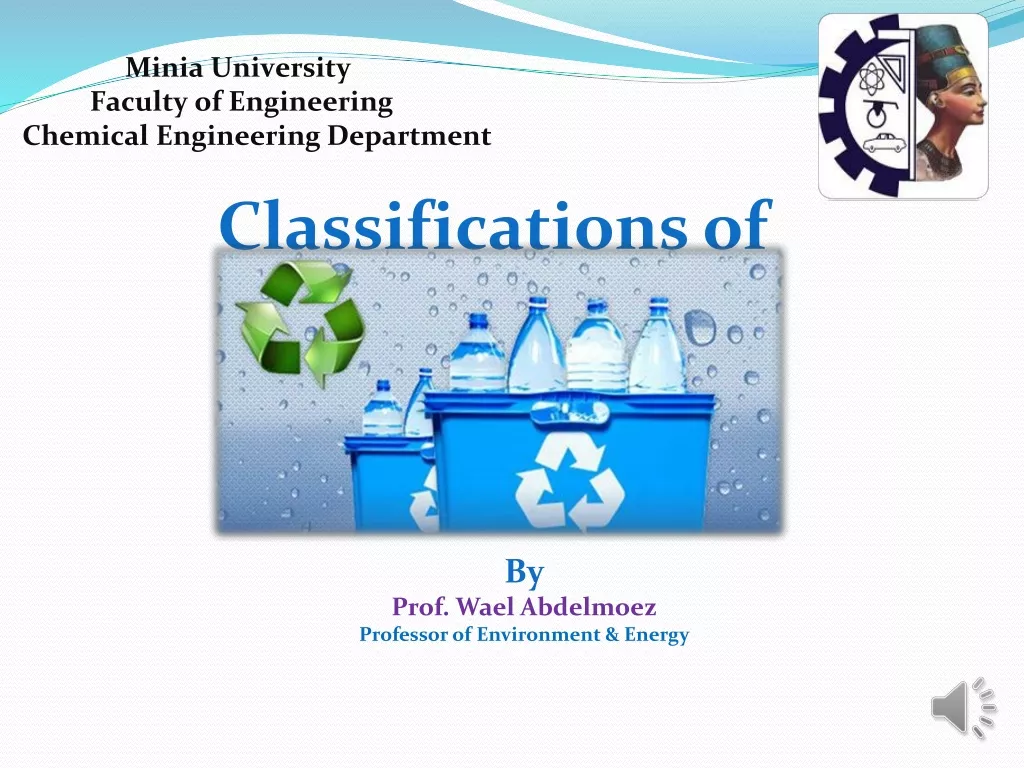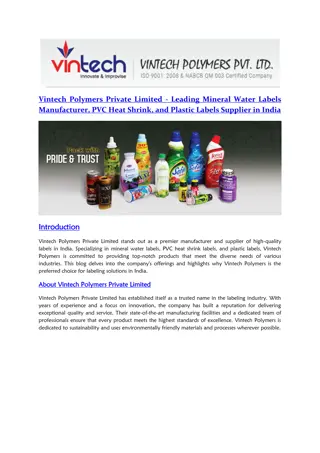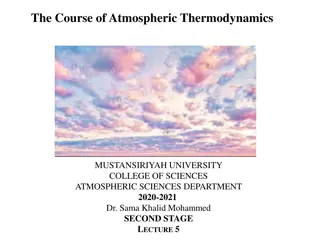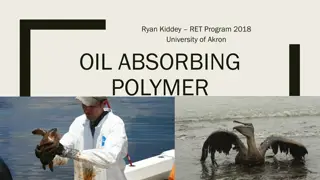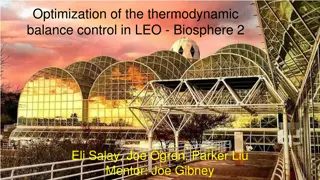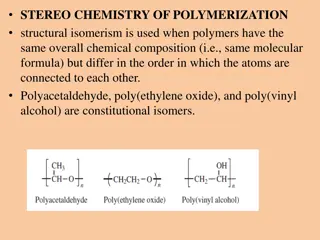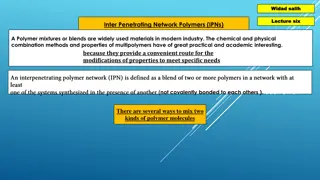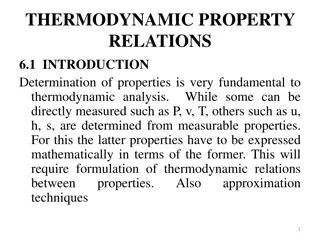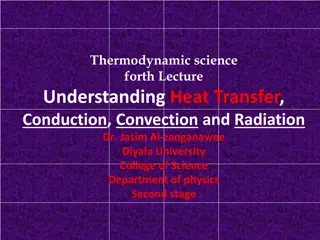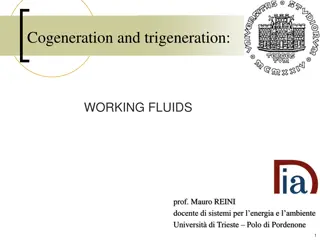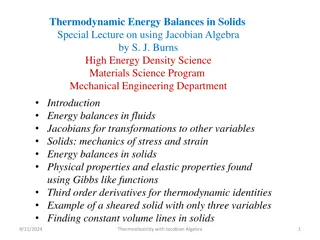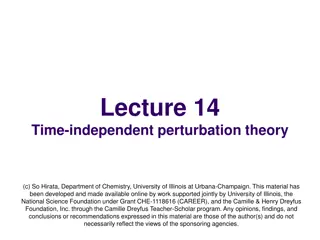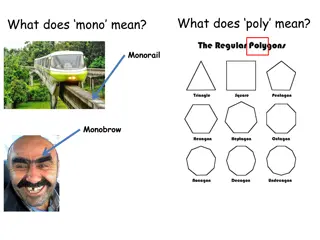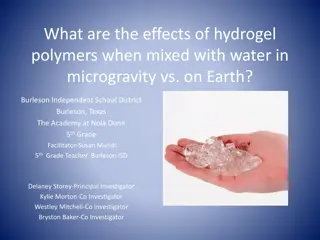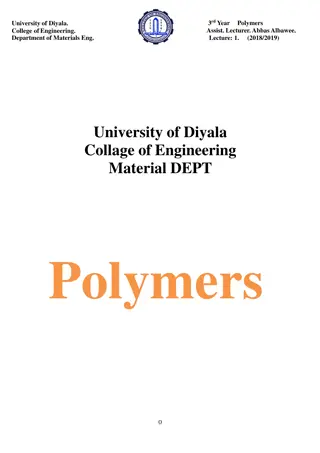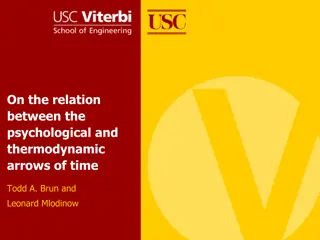Thermodynamic Principles of Polymers in Solution: Flory-Huggins Theory and Macromolecular Solutions
Understanding the thermodynamic behavior of polymers in solution is crucial in various industrial and scientific applications. The Flory-Huggins theory provides insights into athermal macromolecular solutions, heat of mixtures, interaction parameters, and the concept of good vs. mediocre solvents. The regular macromolecular solutions exhibit specific characteristics related to enthalpy, entropy, and free enthalpy of mixtures, shedding light on ideal models for polymer solutions. By exploring these principles, scientists can better predict and control polymer behavior in solution environments.
Download Presentation

Please find below an Image/Link to download the presentation.
The content on the website is provided AS IS for your information and personal use only. It may not be sold, licensed, or shared on other websites without obtaining consent from the author.If you encounter any issues during the download, it is possible that the publisher has removed the file from their server.
You are allowed to download the files provided on this website for personal or commercial use, subject to the condition that they are used lawfully. All files are the property of their respective owners.
The content on the website is provided AS IS for your information and personal use only. It may not be sold, licensed, or shared on other websites without obtaining consent from the author.
E N D
Presentation Transcript
Thermodynamic of polymers in solution
Flory - Huggins theory Athermal macromolecular solutions
1-2. The regular macromolecular solutions A regular solution is characterized by a small value of enthalpy of mixture ( HM) compared with the thermal agitation energy which is alone responsible of the molecular repartition in the liquid network. So, the mixture entropy of regular solution (polymer -solvent) has the same value that attributed to athermal macromolecular solution. This constitutes the ideal model of the real polymer solutions.
1-2.1. Heat of mixtures, Interaction parameter 1,2 In the Flory Huggins theory, the calculation of the mixture heat HMis exactly the same that those evaluated for the mixture enthalpy of the regular simple solution. The segment macromolecular notion drive to the consideration of the elementary interactions solvent-solvent, solvent-segment and segment-segment respectively characterized by the energies 11, 12 and 22.
If z is the adjacent cells to the segment number in the liquid crystalline network model of Flory.
The free enthalpy of mixture (GM) of the regular macromolecular solution, which indicates practically the case of a real solution at weak thermal effect, is: GM= RT(N1Log 1 + N2Log 2+ 12N1 2)
1-2.2. Notion of good solvent and mediocre solvent The dissolution phenomenon of solute (2) in solvent (1) is effective when the free enthalpy of mixture ( GM) take a negative value. As the entropy of mixture is always positive, the dissolution is conditioned essentially by the sign and the heat intensity of the this mixture HM. Therefore, the interaction parameter 12 is measures the quality of a solvent towards a determined polymer.
By analogy with the theory of the simple regular solutions, the expression of the heat of mixture HM calculated from the Flory Huggins theory is affected by a positive sign (endothermic mixture). This is practically true for the majority of macromolecular solutions. Some time, we observe some exceptions when the constituents(solvent and polymer) have a polar structures. Example: the dissolution of the poly(methylmethacrylate) in trichloroethylene give a negative value for HM.
The endothermic macromolecular solutions, which represent the major part of the real cases, are in opposite, characterized by the positive values of the interaction parameters 12.
For a endothermic mixture realized at temperature T, the complete dissolution of the macromolecular solute is the best with the weak interaction parameters. The solvents with the weak interaction parameters is designed by good solvents for the polymer considered . In this way, by example, the natural rubber- carbon tetrachloride, poly(vinyl- tetrahydrofuran chloride) and cellulose nitrate are respectively characterized by 12 = 0.28, 0.14 and 0.27.
On opposite, the solvents with the 12 near 0.5 is designed by the mediocre solvents for the polymer considered . By example, the polyisobutylene is dissolved easily at ordinary temperature in the cyclohexane ( 12= 0.44) than in benzene ( 12 = 0.5). The good solvent and the bad solvent are closely lied to the temperature.
1-3. Real macromolecular solutions In general, in the case of a real macromolecular solution, which the heat of mixture HM take an notable value or which the constitutes of the mixture are more polar, the regular macromolecular solution concept is not applicable. In this fact, for this type of solutions it is impossible to identify the entropy of configuration Sconf. with its entropy of mixture SM. Because the disposition of the macromolecular segments in solution do not only governed by the statistical considerations, and if HM is positive, the segments of macromolecules tempt to withdraw into oneself to favorite the segment-segment interactions.
Now its possible to resume the definition of the different categories of macromolecular solution
2.Macromolecular diluted solutions In general, we admit that the macromolecular chains in solution has practically a homogeny repartition when the fraction volume of solute are superior to 0.04. Before this limit, the effective volumes occupied by the chains can be more or less separated and the Flory-Huggins do not experimentally verified. In particular, the partial molar entropy of solvent take clearly the weak values than the deducted by the calculation. For the such as diluted solutions, the partial molar entropy of solvent can write as fellow.
2.2 Flory and Krigbaum Theory The spherical and stick forms of macromolecules proposed by Zimm and Huggins are in reality two models very simplified. This proposition constitutes two cases diametrically opposed of macromolecules in solution which depended to the solvatation of the solvent. Flory and Krigbaum have calculated the general expressions of the excluded volume u and the second virial coefficient (A2) which characterize the macromolecules gifted by a good flexibility. In the case of a very diluted macromolecular solution , each isolated macromolecule can be definite by a radial function of segments distribution since the mass center of the molecule.
2.2.1 Volume excluded by a flexible macromolecular chain
2.1.2 -Solvent and -temperature One of the principal consequences of the Flory Krigbaum theory is that the excluded volume (u) and the second virial coefficient (A2) are both functions of the interaction parameter 12. When 12 is negative, the case of certain exceptional couples polymer-solvent, the quantity (1/2- 12) is always positive and the excluded volume (u) and the second coefficient of Virial (A2) increase with the absolute value of 12. In this fact, the segment- solvent intermolecular interactions are energetically more favored than the segment-segment intramolecular interactions, this fact induce a strong deployment of each macromolecular ball.
When the interaction parameter is exactly 0.5, the relation (20) shows that the excluded volume is nil. The absolute temperature to which the value of the interaction parameter is 0.5 is called -temperature or Flory temperature. A Such as solvent necessary a mediocre solvent for this polymer taking in the same conditions of temperature is designed as -solvent. -solvent can be a pure liquid or a mixture of liquid. Other definition, the -temperature can be defined more rigourosely as the temperature of the macromolecular solution which the second coefficient of Virial A2 is nil.
Example of experimental determination of interaction parameters Inverse gas chromatography Employed in it inverse state, this technique leads to several parameters as Ha ( heat of absorption), Hd( heat of dissolution), Tg ( glass transition temperature) and the solvent polymer, non solvent polymer and polymer- polymer interaction parameters of Flory.
Inverse state means the injection of a known substance called probe and study of the stationary phase ( polymer).
The principal element in the inverse gas chromatography is the column. The column is treated and loaded by a inert support impregnate by the polymer. The infinite quantity (some l) of molecule probe ( solute) is injected in the column loaded. The retention time of the solvute is taking at the summit of the peak. The retention volume Vg is calculate according to the following equation:
Zone of non equilibrium In this zone the retention mechanism is generally complex, the stationary polymeric phase is in the chromatographic non equilibrium due to the the physic state transition of this phase.
Here, 1(2,3) is related to other binary interaction parameters as shown in the following expression: 1(2,3) = 2 x 12+ 3 x 13+ 2 x 3 x 13
3. Osmotic pressure of diluted macromolecular in solution The osmotic phenomena trough a membrane semi- permeable is widely employed in the physical chemistry macromolecular.
The difference between P and Po is called osmometric pressure = P - Po


